I got two creative speakers from a friend who didn't need that. Since they are only speakers, and not with inbuilt amplifiers, it's not possible to run those speakers from PC/mobile directly.
Amplifier:- Ampifier is an eletronic circuit which increase the power of a signal (here's audio signal). The audio output from a PC/mobile is only few hundred milivolts peak A.C. signal coupled with a series capacitor, so we need an amplifier circuit for driving these speakers (rated at 5W). Note that the wattage is actual maximum wattage handled by the speaker in R.M.S. For some speakers you may see label as 400Watt P.M.P.O, that's not real wattage. It's the peak handle power for the speaker which occurs only at a moment of time. For a decent size room of 100-120sqft, speakers of 10-20watt should be enough. Here is my speakers. Since they are 5watts rated, total wattae comes to 10watts which is pretty normal for home usage. Now I need an amplifier circuit along with a power supply for the same.
After searching local electronics components shop, I found one ready PCB for my needs. It's built around a setreo audio amplifier I.C. viz. A6283 (datasheet-292kb,PDF). A6283 is a well known I.C that's widely used and is on lower cost side. The output is not as good as modern sound systems, but good enough for personal use. The I.C. can deliver 4.6watts each channel with 12V supply, so it's adequate for me. For the peak requirement of 4.6watts per speaker, my power demand comes to 9.2watts which is almost 0.77Amp @ 12V. I had one 12V adapter lying around which came with my broadband router. I see that the adapter is rated at 12V 800mA. So this adapter can deliver the needed power to my amplifier.
Now I gather all the parts required for making the amplifier. Here's the list:
- 1x Enclosure. It's a 3x3 PVC switchboard box in my case. (Rs.18)
- 1xDPDT(SPST/SPDT will also work) switch. (Rs.10)
- 1x LED (Re. 1)
- 1x 1KΩ-1⁄4watts resistor (Re. 1)
- 1x LED Holder (Rs. 3)
- 2x RCA female socket (Rs. 10)
- 1x 22kΩ stereo potentiometer (Rs. 10)
- 1x plastic knob for potentiometer (Rs. 2)
- 1x DC roundpin Socket (Rs. 5)
- 1x 3.5mm stereo audio socket (Rs. 10)
- 1x A6283 Amplifier board (Rs. 30)
Total bill for the parts is Rs.100/-. A general purpose 1Amp 12V adapter should be bought incase you don't have one around. It will cost around 60 Rupees or so.
Now I am setting up the parts inside the enclosure. Front side is for interface and rear is for I/O. So, I install the volume control potentiometer, on/off switch and power status LED(including holder) in the front side. Next I mount the output RCA sockets, input 3.5mm stereo socket and DC socket to the rear. The enclosure box i made with soft plastic so it was east to make the holes by inserting hot soldering iron rather than drilling. If you are doing it by hot soldering iron then remember to keep a piece of damp cloth around. after piercing, when you remove the soldering iron the plastic stuck to the hot iron tip starts burning and produces harmful gases. Wiping the tip of the iron with a damp cloth immediately after piercing helps the plastic stick to your cloth and only a negligible amount of plastic is burnt by the iron tip.
For installing the volume control, follow the diagram as shown below. Incorrect connection will make the amplifier behave unexpectedly.
Now I connect the red (+) wire from amplifier board to the switch and then from the switch's other terminal to the DC socket's +ve pin. The black(-) wire from amplifier board goes directly to the DC socket's -ve pin. The LED is put between the board's power (after the switch). The LED's +ve terminal is connected to the board's 12V (+) through a series resistor of 1KΩ 1⁄4watt value, and the -ve terminal is connected directly.
The output port connections are directly connected from the given points of the circuit board. The input port is connected to amplifier board through the volume control as you can figure out by the above picture.
Now that everything is connected, I give it a trial by connecting two speakers, power supply, and an audio source (an mp3 player). Yes, it works!. I let it run at full volume for 30 minutes this way to check if something overheats or not. After 30 minutes I see the IC is a little hot. Since there is a aluminum heatsink installed this should not be a problem. Now I close the lid of the enclosure. I've designed a simple label for the top of the amplifier. This will make it look more techie, and hide the four screws. Below is the picture of the finished product.
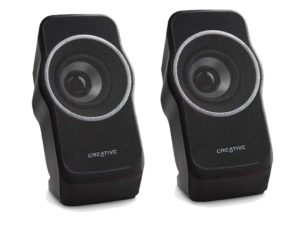
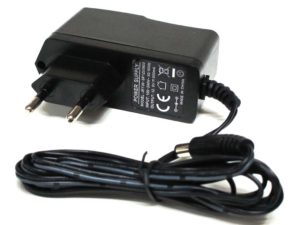
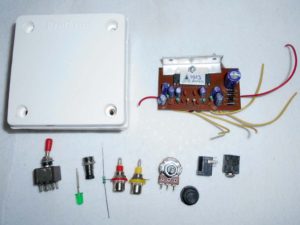
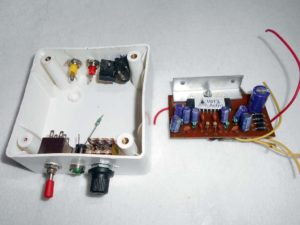
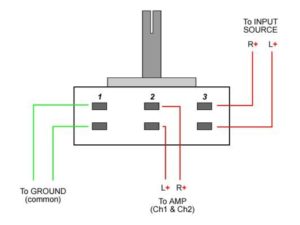
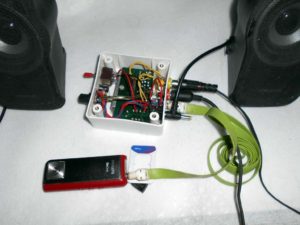
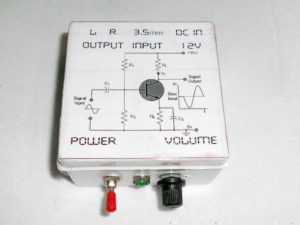
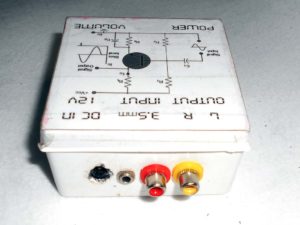
how can we connect a 40 Watt electronic choke with two 20 watt tubes
The tube lights in parallel.
A good work you're doing my friend...
I have pc 2.0 speakers with built in circuit in one speaker with 3.5 input jack for headphones, now the left speaker doesn't work ,one which doesn't house the circuit.
On plugging the earphones/headphones too , the left ear speaker doesn't work .
The left speaker doesn't even make static noise, i did open the speker and there were no burnt components.
What could be the possible reason(s). How can i fix it
I have a 12 V 2000mA Adaptor. Can i use this to connect my 6283 Amplifier and take a 5V from that through a 7805 to play my Bluetooth/USB player?
sure